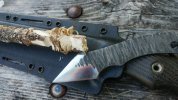Willie71
Warren J. Krywko
- Joined
- Feb 23, 2013
- Messages
- 12,214
I have a question for those of you who know a lot more than me. I have some odd size drops of 3v and z-wear that are thick enough to forge into useable pieces, but would otherwise be scrap. Would forging ruin the advantage of the pm steel or could the grain structure be restored with proper annealing?
Additionally, I’m off most of this week and will be working on my Press. I plan to try mak8ng san Mai with z-wear and cru-wear. What would you guys recommend for the cladding? I have a lot of 304 and 316, and a bit of 410 and 416. Of course I have mild steel, and some 1045 or 1050 too.
Additionally, I’m off most of this week and will be working on my Press. I plan to try mak8ng san Mai with z-wear and cru-wear. What would you guys recommend for the cladding? I have a lot of 304 and 316, and a bit of 410 and 416. Of course I have mild steel, and some 1045 or 1050 too.


